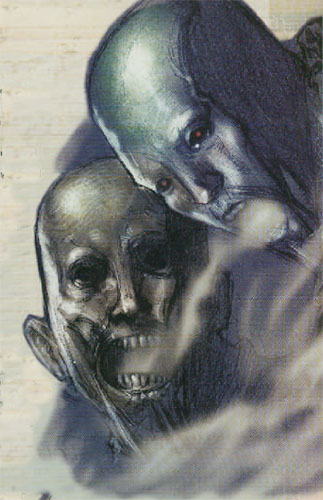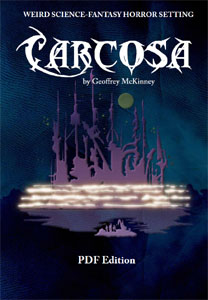As I’ve discussed in the Art of Rulings and Rules vs. Rulings?, among other places, I think it’s important that a DM not allow any interaction at the table to become purely mechanical. Partly this is just an aesthetic preference on my part (it keeps things interesting), partly it’s ideological (rules are associated for a reason), and partly it’s because specificity and detail usually leads to creative gameplay.
Traps are a key example of this. If all you can do with a trap is make a skill check to Search for it, make a skill check to Disable it, and/or take damage from it, then the trap will be fairly boring. You can try to spice that up mechanically or (and this is easier) you can spice it up by being relatively specific about how the trap works. (For example, you might end up with players scavenging the tension ropes that reset a spike trap in order to tie up their kobold prisoner. Or draining the alchemist’s fire through the nozzles of a flame trap. When they disable the pit trap do they wedge it open or use spikes to let it support their weight one at a time? The difference will matter if they end up getting chased back down that hall by ogres.)
In following this doctrine, I’ve found that it can occasionally be difficult to imagine what disarming a magical trap really looks like. I mean, if it’s just magical potential hanging in the air waiting for an alarm spell to go off, what is the rogue doing, exactly, when they make their Disable Device check? And what are they actually sensing with their Search checks?
To that end, here are a few techniques I use when thinking about magical traps.
Magical Potential: Permanent and semi-permanent magical effects will leave a very subtle “impression” on the physical world. Careful characters with great sensitivity can detect the presence of a magical field. In some cases this may be the first step in identifying how to bypass or disable the magical trap; in other cases, it may turn out that the trap can’t be disabled without something like dispel magic (but at least the rogue can figure out where it’s safe to walk and where it isn’t).
Ethereal Hooks: Ethereal hooks are attached to spell potential stored on the Ethereal Plane. When the ethereal hooks are “tugged”, they yank the spell potential back from the Ethereal Plane and the energy of the planar transition triggers the spell effect. Ethereal hooks are particularly useful for warding physical objects (i.e., traps which are triggered when you pick up an item). They can also be attached to physical tripwires. In either case, the ethereal hooks require some physical substance and can be safely dislodged if sufficient care is taken.
Spellsparks: Tiny spheres or cylinders made from small amounts of mithril and taurum (true gold). Spellsparks impact areas of spell potential and complete the casting. A typical application would be a spellspark attached to the bottom of a trigger plate: Step on the plate, the spellspark depresses and triggers a fireball. But if you can remove the spellspark, the spell potential is as harmless as a block of C4 without a detonator. (A divine variant of the spellspark is to douse a small prayer wheel in holy or unholy water.)
Smudging Sigils: This is almost always the case for things like a symbol of death, but quite a few other spell effects can also be “stored” as arcane or divine sigils using the proper techniques. You generally can’t just reach out and smear the thing (that’ll usually trigger the effect; spellcasters aren’t stupid). But if you’ve got the proper training, then you can usually identify exactly where you need to smudge the sigil to negate its effects.
Counterchanting: Spell effects with verbal components still resonate with those chants even after the casting is complete. By using proper counterchanting techniques, a character can weaken those resonances and eventually dissipate the spell effect. (This isn’t like counterspelling: The counterchanting is too slow a process to use on a spell as its being cast. It only works here because the spell is being held in a stored state.)
Concealed Material Components: In some cases, spell effects built into traps still require the material components of the spell to be present in order for the spell to be triggered. These are usually concealed in the trap somewhere. (For example, a fireball trap might have a bit of sulfur tucked away.) If you can remove the concealed material component without triggering the trap, then the trap is rendered impotent.
Arcane/Divine Focuses: Other spell-storing techniques require the presence of a physical talisman or focus. In some cases, removing the focus will cause the spell energies to dissipate harmlessly. In other cases, it will just defang the spell — which means that it could be triggered again if the focus were restored.
Bypass Passwords: Some spellcasters will intentionally build bypass passwords into their traps. If the builder was cautious, these can be quite difficult to determine. But many spellcasters will simply draw on a common lore of such phrases. In other cases, casters may not be aware of (or simply choose not to bother changing) standard bypasses built into the most common forms of certain rituals. Like Gandalf standing before the doors of Moria, characters with proper training can often run through their stock of common passwords and discover that they’ve managed to disable the trap without any real danger. (Some caution is required, however: Some trap-makers anticipate this sort of thing and will instead have the trap trigger if certain false passwords are given.)
Telepathic Completion: This is a subtle technique. The spell effect actually reaches out telepathically and sends a completion word; the power of the victim’s own thoughts will trigger the trap. (This means that characters immune to mind-affecting effects and/or telepathic communication can’t trigger the trap. This often means that undead can freely cross through the trap.) Rogues holding a proper counter-command in their thoughts while moving through the triggering zone of the trap can disrupt the delicate telepathic effect for a limited amount of time (say, 1d4 minutes), allowing others to pass through safely.
Clockwork Mechanisms: Spells can be stored inside clockwork mechanisms. Physically disabling the clockworks will disable the magical trap. Nice and simple.
Thoughts? What other techniques could we be using here?
As a final utilitarian note: I’ll only rarely include these specific details into my notes. Instead, this is just a conceptual toolkit that I can use to explain the working of any trap as it comes up during play. Similarly, I usually don’t spend time prepping the exact mechanics of how a particular pit trap works (one door or two? where are the hinges? are there hinges? what are the spikes at the bottom made out of? etc.).
















